Unveiling Galaxy Formation and Black Hole Growth through Ultra-Low Frequency Gravitational Waves
This project aims to build a novel framework to study supermassive black holes via their unique gravitational wave signatures, providing a multi-messenger tool to constrain galaxy formation in the early universe.
This is a joint project between CGA/RSPhys and RSAA. Co-supervisor at RSAA: Dr Yuxiang Qin (yuxiang.qin@anu.edu.au)
Project status
Content navigation
About

Synopsis
This project aims to build a novel framework to study supermassive black holes via their unique gravitational wave signatures, providing a multi-messenger tool to constrain galaxy formation in the early universe.
This is a joint project between CGA/RSPhys and RSAA. Co-supervisor at RSAA: Dr Yuxiang Qin (yuxiang.qin@anu.edu.au)
Description
This is a joint project between CGA/RSPhys and RSAA. Co-supervisor at RSAA: Dr Yuxiang Qin (yuxiang.qin@anu.edu.au)
Supermassive black holes (SMBHs) are expected to reside at the centre of every galaxy. The active galactic nucleus (AGN) heats or even ejects gas from its host galaxy during periods of rapid accretion, thereby altering subsequent star formation episodes within the galaxy. Observations of SMBHs in the early universe have largely been limited to a small sample of luminous quasars or massive quiescent galaxies whose star formation may be quenched by AGN feedback. This project aims to explore a novel multi-messenger approach to study high-redshift SMBHs via their unique gravitational wave (GW) signatures, offering a new avenue to constrain galaxy formation and test general relativity physics.
In recent decades, tremendous efforts and successes have been made in detecting GWs from stellar-mass compact objects. Ground-based GW detector network involving LIGO, Virgo, and KAGRA has observed hundreds of compact binary merger events that involve neutron stars and/or black holes with masses about tens of times that of our Sun. However, GW signals from SMBHs are anticipated at much lower frequencies, which are way beyond the sensitive band of these ground-based detectors but might be captured by pulsar timing arrays (PTAs) that can measure GWs at ultra-low frequencies by analysing the arrival times of radio pulses from an array of millisecond pulsars. Furthermore, the next-generation space-based GW observatory, the Laser Interferometer Space Antenna (LISA), featuring three spacecraft arranged in an equilateral triangle with each 2.5 million kilometres apart, is designed to measure GWs produced by merging SMBHs. This project will build a theoretical framework to study galaxy formation using current limits from PTAs as well as potential SMBH GW signals from future LISA observations.
We have developed a semi-analytic galaxy-formation model that incorporates AGN feedback and tracks the growth and merger of SMBHs. The accretion rate of these high-redshift SMBHs determines both the brightness of the host galaxy and the SMBH mass, which in turn affects the GW signals. Therefore, current PTA observations and upcoming GW experiments from LISA offer a promising opportunity to refine galaxy formation models and probe general relativity at galactic scales. This project will involve forward-modelling of GW signals from SMBHs and performing Bayesian inferences against PTA and mock LISA observations, utilizing machine-learning algorithms to enhance accuracy and efficiency.

